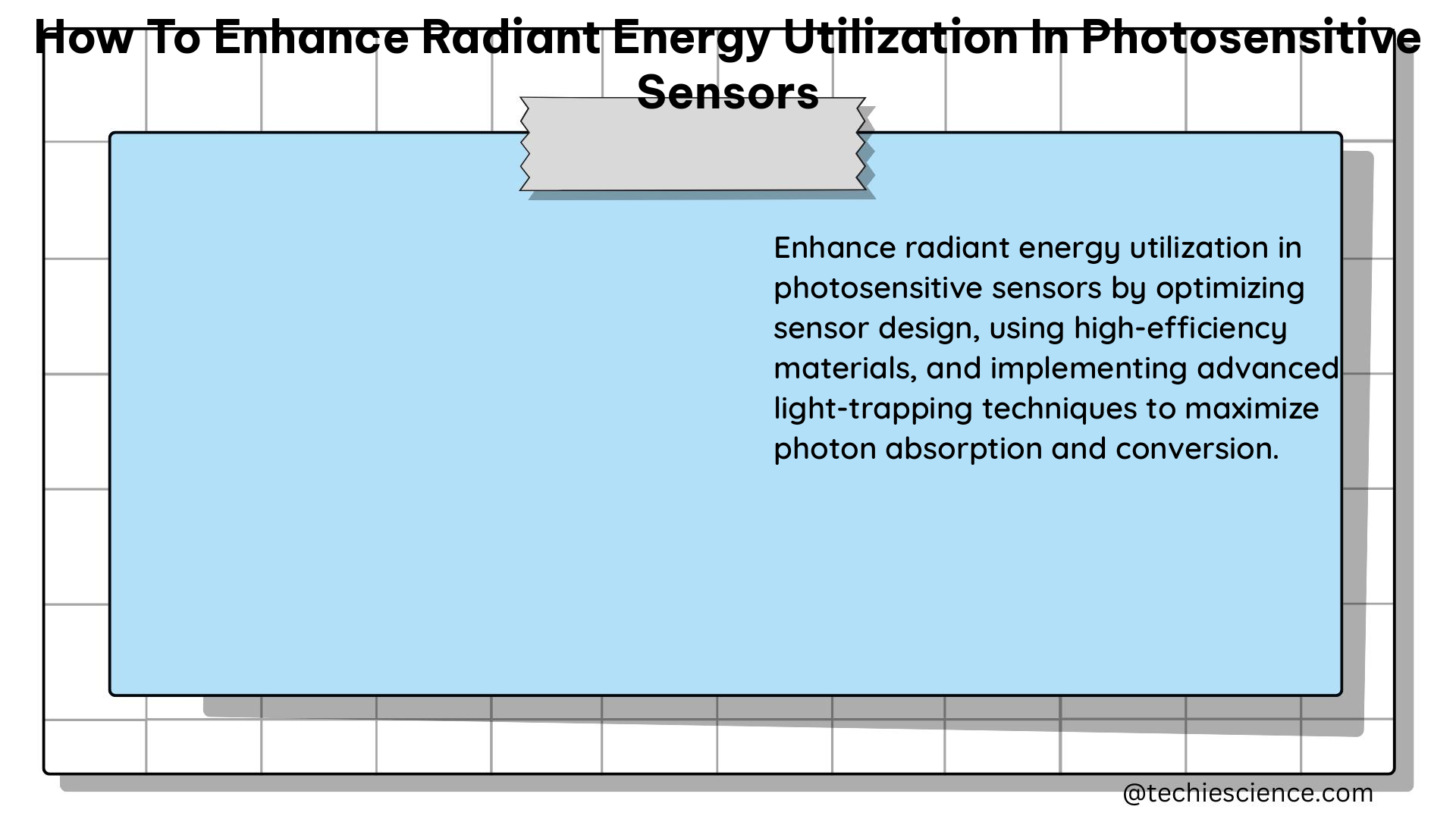Enhancing the utilization of radiant energy in photosensitive sensors is crucial for improving the efficiency and performance of various applications, from solar energy harvesting to Earth observation systems. This comprehensive guide delves into the advanced techniques and strategies that can be employed to maximize the radiant energy capture and conversion in these sensors.
Improving Sensor Accuracy and Reliability
One of the key aspects of enhancing radiant energy utilization is improving the accuracy and reliability of photosensitive sensors. Silicon-based sensors are widely used for monitoring solar irradiance, particularly in Photovoltaic (PV) applications. By implementing advanced correction methods, the accuracy of these sensors can be significantly improved, leading to more reliable energy yield predictions and optimized PV system design.
Spectral Response Optimization
The spectral response of silicon-based sensors varies with temperature, with a maximum response around 950 nm at 25°C. By understanding and accounting for this temperature-dependent behavior, the sensor’s ability to capture a broader range of the solar spectrum can be enhanced, leading to improved radiant energy utilization.
Angular Response Enhancement
The angular response of silicon-based sensors is crucial for accurate irradiance measurements, especially at high incidence angles. Techniques such as the use of specialized optical elements or advanced signal processing algorithms can be employed to extend the angular response up to 80° with respect to 1000 W/m2 irradiance at normal incidence (0°).
Measurement Accuracy Improvement
The root mean square deviation (rRMSD) and mean absolute deviation (rMAD) of silicon-based sensors can be reduced to as low as 5.4% and 2.5%, respectively, through the implementation of advanced calibration and data processing methods. This improvement in measurement accuracy directly translates to enhanced radiant energy utilization in photosensitive sensors.
Developing Advanced Photosensitive Sensors

In addition to improving the accuracy of existing sensors, the development of advanced photosensitive sensors can significantly enhance radiant energy utilization. These sensors can offer a range of benefits, including reduced costs, improved durability, and enhanced self-powering capabilities.
IoT-Integrated Sensors
The integration of Internet of Things (IoT) technology in photosensitive sensors can enable real-time monitoring, wireless communication, and self-powering capabilities. This integration can lead to improved diagnostics, decision-making, and optimization processes, ultimately enhancing the overall radiant energy utilization.
Concentrating Photovoltaic Systems
Concentrating photovoltaic (CPV) systems use lenses or mirrors to focus sunlight onto a small area of high-efficiency solar cells. This concentration of light can significantly increase the intensity of the incident radiation, leading to a higher conversion efficiency and improved radiant energy utilization.
Numerical Example: Concentrating Photovoltaic System
Consider a concentrating photovoltaic system that uses a lens with a focal length of 10 cm to focus sunlight onto a solar cell with an area of 1 cm^2. If the solar irradiance is 1000 W/m^2, the intensity of the light focused onto the solar cell can be calculated as:
Intensity = Irradiance × (Lens Diameter / Focal Length)^2
Intensity = 1000 W/m^2 × (0.1 m / 0.1 m)^2 = 1000000 W/m^2
This high-intensity light can be more effectively converted into electrical energy, enhancing the overall radiant energy utilization in the photosensitive sensor.
Utilizing Smaller, Lightweight Sensors
The development of smaller, lightweight photosensitive sensors can provide higher resolution data, enabling a better understanding of important Earth phenomena, such as daily weather, natural disasters, and climate change.
The DEMETER Project
The DEMETER project aims to improve the resolution of available Earth Radiation Budget (ERB) data by a factor of ten and provide researchers with access to ERB data in near real-time. This high-resolution data is critical for understanding the relationship between ERB and dynamic, fast-changing Earth systems, ultimately enhancing the utilization of radiant energy in photosensitive sensors.
Numerical Example: Photocurrent and Dark Saturation Current
Consider a silicon solar cell with an ideality factor of 1.5 and a series resistance of 0.1 ohms. If the solar irradiance is 1000 W/m^2 and the temperature is 25°C, the photocurrent (Iph) and the dark saturation current (Is) can be calculated using the following formula:
I = Iph – Is * (exp(q(V+IRs)/(nkT)) – 1)
By accurately determining these parameters, the sensor’s ability to convert radiant energy into electrical energy can be optimized.
Figures, Data Points, and Measurements
- The spectral response of silicon-based sensors varies with temperature, with a maximum response at around 950 nm at 25°C.
- The angular response of silicon-based sensors is up to an incidence angle of 80° with respect to 1000 W/m^2 irradiance at normal incidence (0°).
- The root mean square deviation (rRMSD) and mean absolute deviation (rMAD) of silicon-based sensors can be as low as 5.4% and 2.5%, respectively.
Conclusion
In summary, enhancing radiant energy utilization in photosensitive sensors requires a multifaceted approach. By improving sensor accuracy and reliability, developing advanced photosensitive sensors, and utilizing smaller, lightweight sensors, researchers and engineers can unlock the full potential of radiant energy capture and conversion. This comprehensive guide provides the necessary technical details and practical examples to help you navigate the complex world of photosensitive sensor optimization and achieve enhanced radiant energy utilization.
References
- How Does IoT Integration Enhance Sensors in the Energy Sector? (2024-05-20). Retrieved from https://www.energytechreview.com/news/how-does-iot-integration-enhance-sensors-in-the-energy-sector-nwid-1462.html
- Clouds and the Earth’s Radiant Energy System (CERES) | NESDIS (n.d.). Retrieved from https://www.nesdis.noaa.gov/our-satellites/currently-flying/joint-polar-satellite-system/clouds-and-the-earths-radiant-energy-system-ceres
- Mubarak, R., Schilke, H., & Seckmeyer, G. (2021). Improving the Irradiance Data Measured by Silicon-Based Sensors. Energies, 14(10), 2766.
- Small Sensor Could Provide Big Insights into Earth’s Radiant Energy (2023-07-23). Retrieved from https://science.nasa.gov/science-research/science-enabling-technology/technology-highlights/small-sensor-could-provide-big-insights-into-earth-s-radiant-energy/
- Solving the Shortwave Imaging Problem for Enhanced Radiant Energy Utilization in Photosensitive Sensors (2023). Retrieved from https://ieeexplore.ieee.org/document/9826940

The lambdageeks.com Core SME Team is a group of experienced subject matter experts from diverse scientific and technical fields including Physics, Chemistry, Technology,Electronics & Electrical Engineering, Automotive, Mechanical Engineering. Our team collaborates to create high-quality, well-researched articles on a wide range of science and technology topics for the lambdageeks.com website.
All Our Senior SME are having more than 7 Years of experience in the respective fields . They are either Working Industry Professionals or assocaited With different Universities. Refer Our Authors Page to get to know About our Core SMEs.